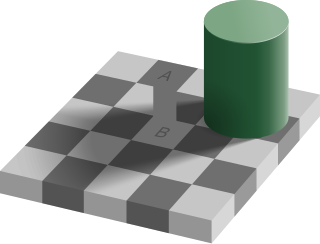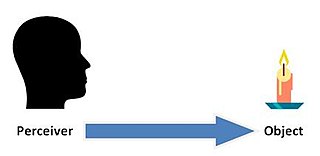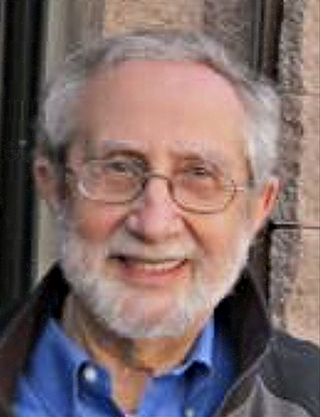Related Research Articles

Consciousness, at its simplest, is awareness of internal and external existence. However, its nature has led to millennia of analyzes, explanations and debates by philosophers, theologians, linguists, and scientists. Opinions differ about what exactly needs to be studied or even considered consciousness. In some explanations, it is synonymous with the mind, and at other times, an aspect of mind. In the past, it was one's "inner life", the world of introspection, of private thought, imagination and volition. Today, it often includes any kind of cognition, experience, feeling or perception. It may be awareness, awareness of awareness, or self-awareness either continuously changing or not. The disparate range of research, notions and speculations raises a curiosity about whether the right questions are being asked.

The mind is that which thinks, imagines, remembers, wills, and senses, or is the set of faculties responsible for such phenomena. The mind is also associated with experiencing perception, pleasure and pain, belief, desire, intention, and emotion. The mind can include conscious and non-conscious states as well as sensory and non-sensory experiences.

The philosophy of perception is concerned with the nature of perceptual experience and the status of perceptual data, in particular how they relate to beliefs about, or knowledge of, the world. Any explicit account of perception requires a commitment to one of a variety of ontological or metaphysical views. Philosophers distinguish internalist accounts, which assume that perceptions of objects, and knowledge or beliefs about them, are aspects of an individual's mind, and externalist accounts, which state that they constitute real aspects of the world external to the individual. The position of naïve realism—the 'everyday' impression of physical objects constituting what is perceived—is to some extent contradicted by the occurrence of perceptual illusions and hallucinations and the relativity of perceptual experience as well as certain insights in science. Realist conceptions include phenomenalism and direct and indirect realism. Anti-realist conceptions include idealism and skepticism. Recent philosophical work have expanded on the philosophical features of perception by going beyond the single paradigm of vision.
The unconscious mind consists of processes in the mind that occur automatically and are not available to introspection. Although these processes exist beneath the surface of conscious awareness, they are thought to exert an effect on conscious thought processes and behavior. Empirical evidence suggests that unconscious phenomena include repressed feelings and desires, memories, automatic skills, subliminal perceptions, and automatic reactions. The term was coined by the 18th-century German Romantic philosopher Friedrich Schelling and later introduced into English by the poet and essayist Samuel Taylor Coleridge.
In philosophy of mind, neuroscience, and cognitive science, a mental image is an experience that, on most occasions, significantly resembles the experience of "perceiving" some object, event, or scene, but occurs when the relevant object, event, or scene is not actually present to the senses. There are sometimes episodes, particularly on falling asleep and waking up, when the mental imagery may be dynamic, phantasmagoric and involuntary in character, repeatedly presenting identifiable objects or actions, spilling over from waking events, or defying perception, presenting a kaleidoscopic field, in which no distinct object can be discerned. Mental imagery can sometimes produce the same effects as would be produced by the behavior or experience imagined.

In the philosophy of perception and philosophy of mind, direct or naïve realism, as opposed to indirect or representational realism, are differing models that describe the nature of conscious experiences; out of the metaphysical question of whether the world we see around us is the real world itself or merely an internal perceptual copy of that world generated by our conscious experience.
The consciousness and binding problem is the problem of how objects, background and abstract or emotional features are combined into a single experience.
Global workspace theory (GWT) is a simple cognitive architecture that has been developed to account qualitatively for a large set of matched pairs of conscious and unconscious processes. It was proposed by Bernard Baars. Brain interpretations and computational simulations of GWT are the focus of current research.
A mental state, or a mental property, is a state of mind of a person. Mental states comprise a diverse class, including perception, pain/pleasure experience, belief, desire, intention, emotion, and memory. There is controversy concerning the exact definition of the term. According to epistemic approaches, the essential mark of mental states is that their subject has privileged epistemic access while others can only infer their existence from outward signs. Consciousness-based approaches hold that all mental states are either conscious themselves or stand in the right relation to conscious states. Intentionality-based approaches, on the other hand, see the power of minds to refer to objects and represent the world as the mark of the mental. According to functionalist approaches, mental states are defined in terms of their role in the causal network independent of their intrinsic properties. Some philosophers deny all the aforementioned approaches by holding that the term "mental" refers to a cluster of loosely related ideas without an underlying unifying feature shared by all. Various overlapping classifications of mental states have been proposed. Important distinctions group mental phenomena together according to whether they are sensory, propositional, intentional, conscious or occurrent. Sensory states involve sense impressions like visual perceptions or bodily pains. Propositional attitudes, like beliefs and desires, are relations a subject has to a proposition. The characteristic of intentional states is that they refer to or are about objects or states of affairs. Conscious states are part of the phenomenal experience while occurrent states are causally efficacious within the owner's mind, with or without consciousness. An influential classification of mental states is due to Franz Brentano, who argues that there are only three basic kinds: presentations, judgments, and phenomena of love and hate.
Apperception is any of several aspects of perception and consciousness in such fields as psychology, philosophy and epistemology.
A mental representation, in philosophy of mind, cognitive psychology, neuroscience, and cognitive science, is a hypothetical internal cognitive symbol that represents external reality or its abstractions.
Jeffrey Alan Gray was a British psychologist who is notable for his contributions to the theory of consciousness.
William G. Lycan is an American philosopher and professor emeritus at University of North Carolina at Chapel Hill, where he was formerly the William Rand Kenan, Jr. Distinguished Professor. Since 2011, Lycan is also distinguished visiting professor of philosophy at the University of Connecticut, where he continues to research, teach, and advise graduate students.

David Rosenthal is an American philosopher who has made significant contributions to the philosophy of mind, particularly in the area of consciousness and related topics. He is professor of philosophy at the Graduate Center of the City University of New York (CUNY). He was educated at the University of Chicago and then Princeton University. Rosenthal also has research interests in cognitive science, and is Coordinator of the CUNY Graduate Center's Interdisciplinary Concentration in Cognitive Science. And he has done work in philosophy of language, metaphysics, ancient philosophy, and 17th-century rationalism.

Peter Carruthers is a British-American philosopher and cognitive scientist working primarily in the area of philosophy of mind, though he has also made contributions to philosophy of language and ethics. He is a professor of philosophy at the University of Maryland, College Park, an associate member of Neuroscience and Cognitive Science Program, and a member of the Committee for Philosophy and the Sciences.
Primary consciousness is a term the American biologist Gerald Edelman coined to describe the ability, found in humans and some animals, to integrate observed events with memory to create an awareness of the present and immediate past of the world around them. This form of consciousness is also sometimes called "sensory consciousness". Put another way, primary consciousness is the presence of various subjective sensory contents of consciousness such as sensations, perceptions, and mental images. For example, primary consciousness includes a person's experience of the blueness of the ocean, a bird's song, and the feeling of pain. Thus, primary consciousness refers to being mentally aware of things in the world in the present without any sense of past and future; it is composed of mental images bound to a time around the measurable present.

The neural correlates of consciousness (NCC) refer to the relationships between mental states and neural states and constitute the minimal set of neuronal events and mechanisms sufficient for a specific conscious percept. Neuroscientists use empirical approaches to discover neural correlates of subjective phenomena; that is, neural changes which necessarily and regularly correlate with a specific experience. The set should be minimal because, under the materialist assumption that the brain is sufficient to give rise to any given conscious experience, the question is which of its components are necessary to produce it.
A model of self, is our being here physically at any moment in time. A self-model is the central concept in the theory of consciousness called the self-model theory of subjectivity (SMT). This concept comprises experiences of ownership, of first person perspective, and of a long-term unity of beliefs and attitudes. These features are instantiated in the prefrontal cortex. This theory is an interdisciplinary approach to understanding and explaining the phenomenology of consciousness and the self. This theory has two core contents, the phenomenal self-model (PSM) and the phenomenal model of the intentionality relation (PMIR). Thomas Metzinger advanced the theory in his 1993 book Subjekt und Selbstmodell.
The theory of sense data is a view in the philosophy of perception, popularly held in the early 20th century by philosophers such as Bertrand Russell, C. D. Broad, H. H. Price, A. J. Ayer, and G. E. Moore. Sense data are taken to be mind-dependent objects whose existence and properties are known directly to us in perception. These objects are unanalyzed experiences inside the mind, which appear to subsequent more advanced mental operations exactly as they are.

Consciousness and the Brain: Deciphering How the Brain Codes Our Thoughts is a 2014 book by Stanislas Dehaene. It summarizes research on the neuroscience of consciousness, particularly from recent decades.
References
- 1 2 3 4 5 6 7 8 9 10 11 12 13 14 Peter Carruthers (15 Aug 2011). "Higher-Order Theories of Consciousness". Stanford Encyclopedia of Philosophy. Retrieved 31 August 2014.
- ↑ David Rosenthal; Josh Weisberg (2008). "Higher-order theories of consciousness". Scholarpedia. 3 (5): 4407. Bibcode:2008SchpJ...3.4407R. doi: 10.4249/scholarpedia.4407 .
- ↑ Droege, Paula. "Higher-Order Theories of Consciousness". Internet Encyclopedia of Philosophy. Retrieved 31 August 2014.
- 1 2 3 4 5 6 7 8 9 Hakwan Lau; David Rosenthal (Aug 2011). "Empirical support for higher-order theories of conscious awareness" (PDF). Trends in Cognitive Sciences. 15 (8): 365–373. doi:10.1016/j.tics.2011.05.009. PMID 21737339. S2CID 32235393.
- ↑ Picciuto, Vincent (2014). Consciousness and Mental Quotation: An intrinsic higher-order approach (PhD thesis). University of Maryland. hdl: 1903/15231 .
- 1 2 Edmund T. Rolls (2005). Emotion Explained. Oxford University Press. ISBN 978-0-19-857003-5.
- ↑ Sturgeon, Scott (2000). Matters of Mind: Consciousness, Reason and Nature. London: Routledge.
- ↑ Carruthers, Peter (2000). Phenomenal Consciousness: A Naturalistic Theory. Cambridge: Cambridge University Press.